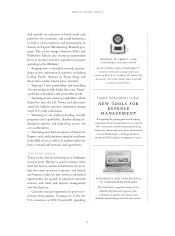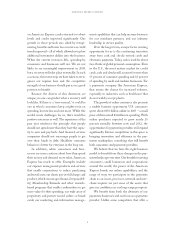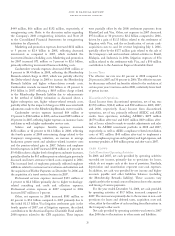American Express 2008 Annual Report Download - page 20
Download and view the complete annual report
Please find page 20 of the 2008 American Express annual report below. You can navigate through the pages in the report by either clicking on the pages listed below, or by using the keyword search tool below to find specific information within the annual report.
2008 financial review
american express company
fair value measurement
Description Assumptions/Approach Used Effect if Actual Results Differ
from Assumptions
The Company holds investment securities,
certain subordinated interests in securitized
cardmember loans from the Company’s
securitization programs and derivative
instruments. These financial instruments
are reflected at fair value on the Company’s
Consolidated Balance Sheets. Management
will make significant assumptions and
judgments when estimating fair value for
these financial instruments.
Investment Securities
The Company’s investment securities are
comprised of predominantly fixed-income
securities issued by states and municipalities,
as well as the U.S. Government and agencies
(e.g., Fannie Mae, Freddie Mac) and retained
subordinated securities described further
below. The investment securities are classified
as available-for-sale with changes in fair value
recorded in accumulated other comprehensive
(loss) income within shareholders’ equity on
the Company’s Consolidated Balance Sheets
(except for approximately $213 million
of investment securities included in
discontinued operations, for which changes in
fair value are recorded in (loss) income from
discontinued operations in the Company’s
Consolidated Statements of Income).
Securitized Cardmember Loans
When the Company securitizes cardmember
loans, they are accounted for as sales and
the loans are removed from the Company’s
Consolidated Balance Sheets. The Company
retains certain subordinated interests in the
securitized cardmember loans, which may
include one or more investments in tranches
of the securitization (retained subordinated
securities) and an interest-only strip.
In accordance with Statement of Financial
Accounting Standards (SFAS) No. 157 “Fair
Value Measurements” (SFAS No. 157) the
objective of a fair value measurement is to
determine the price that would be received
to sell an asset or paid to transfer a liability
in an orderly transaction between market
participants at the measurement date (an exit
price). SFAS No. 157 established a three-
level hierarchy of valuation techniques used
to measure fair value. The fair value hierarchy
gives the highest priority to the measurement
of fair value based on unadjusted quoted
prices in active markets for identical assets
or liabilities (Level 1), followed by the
measurement of fair value based on pricing
models with significant observable inputs
(Level 2), with the lowest priority given
to the measurement of fair value based on
pricing models with significant unobservable
inputs (Level 3).
Investment Securities
The fair market values for the Company’s
investment securities (excluding its retained
subordinated securities, which are discussed
further below) are obtained primarily from
pricing services engaged by the Company,
and the Company receives one price for
each security. The fair values provided
by the pricing services are estimated by
using pricing models, where the inputs
to those models are based on observable
market inputs. The inputs to the valuation
techniques applied by the pricing services
vary depending on the type of security
being priced but are typically benchmark
yields, benchmark security prices, credit
spreads, prepayment speeds, reported trades,
broker-dealer quotes, all with reasonable
levels of transparency. The pricing services
do not apply any adjustments to the pricing
models used, nor does the Company apply
any adjustments to prices received from the
pricing services. As of December 31, 2008,
all of the Company’s investment securities are
classified in Level 2 of the fair value hierarchy.
See further in Note 5 to the Company’s
Consolidated Financial Statements.
Retained Subordinated Securities and Interest-
Only Strip
The fair value of the Company’s retained
subordinated securities and interest-only
strip are determined using discounted cash
flow models.
(continued on next page)
Investment Securities
In the measurement of fair value for the
Company’s investment securities (excluding
its retained subordinated securities, which
are discussed further below), even though the
underlying inputs used in the pricing models
are directly observable from active markets or
recent trades of similar securities in inactive
markets, the pricing models do entail a certain
amount of subjectivity and therefore differing
judgments in how the underlying inputs are
modeled could result in different estimates of
fair value.
Retained Subordinated Securities and Interest-
Only Strip
In measuring the fair value for the
Company’s retained subordinated securities,
the fair value is impacted by external market
factors including LIBOR forward rates
and credit spreads, and therefore, the use
of different inputs to the measurement
of fair value of the Company’s retained
subordinated securities could result in a
different fair value measurement.
The fair value of the interest-only strip
is impacted by changes in the estimates
and assumptions used in the valuation
models. The use of different inputs to the
measurement of fair value of these financial
instruments could result in a different fair
value measurement.
Refer to Note 6 to the Company’s
Consolidated Financial Statements, including
sensitivity analyses relating to changes in key
assumptions for the retained subordinated
securities and interest-only strip.
18
























